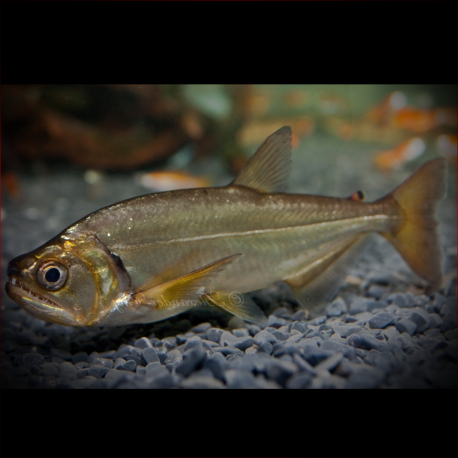More info
Datasheet
| Minimum Tank Size | 10000 litres / 2641.72 US gallons |
| Maximum Size | 66.0cm / 25.98inches |
| Temperature | 24°C / 75.20°F - 28°C / 82.40°F |
| Hardness | 2.02dgH / 36ppm - 15.02dgH / 268ppm |
| pH | 6.0-8.0 |
General Description
Hydrolycus armatus, commonly known as Payara, is a member of the Cynodontidae family. It features a silvery body and head that is slightly darker dorsally, with hyaline fins showing yellowish hues at the proximal sections of the caudal and anal fins. This species can grow up to 66.0 cm in length and is often confused with its smaller relative, H. scomberoides. Its distinguishing features include black subdistal bands on the caudal and anal fins with white margins and dorsal-fin rays with dark pigmentation.
Aquarium Setup
For housing Hydrolycus armatus, a tank with a minimum capacity of 10000 litres is necessary. The aquarium setup should include a high level of dissolved oxygen, moderate water movement facilitated by filters, powerheads, and airstones. Stable water conditions are crucial, and regular water changes of 30-50% of the aquarium volume per week are recommended. Due to their jumping capabilities, a secure lid is essential to prevent escape.
Behaviour
The Payara is known for its aggressive nature, particularly towards similar-looking and conspecific fishes. Therefore, it is best kept either alone or with large benthic species like Potamotrygon spp.
Feeding and Diet
As an obligate piscivore, Hydrolycus armatus preys on fish up to half its size. Newly imported specimens may initially reject anything other than live fish, but they can be transitioned to dead alternatives. It is advised to avoid feeding them mammalian or avian meat and opt for properly conditioned, high-nutrition food sources to prevent disease introduction.
Reproduction & Dimorphism
Information on the reproduction of Hydrolycus armatus is currently undocumented, leaving details of its breeding habits unknown.
Habitat and Distribution
Typically pelagic, adult Payara prefer flowing areas in main river channels and larger tributaries. They are native to regions such as the eastern Amazon basin in Brazil, the Río Orinoco in Venezuela, and the Essequibo drainage in Guyana. In fluvial populations, reproduction occurs from November to April, with adults migrating upstream during this period. Juvenile Payara are likely found in smaller tributaries and flooded forest areas.
By following the guidelines for tank setup, understanding their behavior, feeding habits, and habitat preferences, aquarists can provide a suitable environment for these striking predatory fish.

